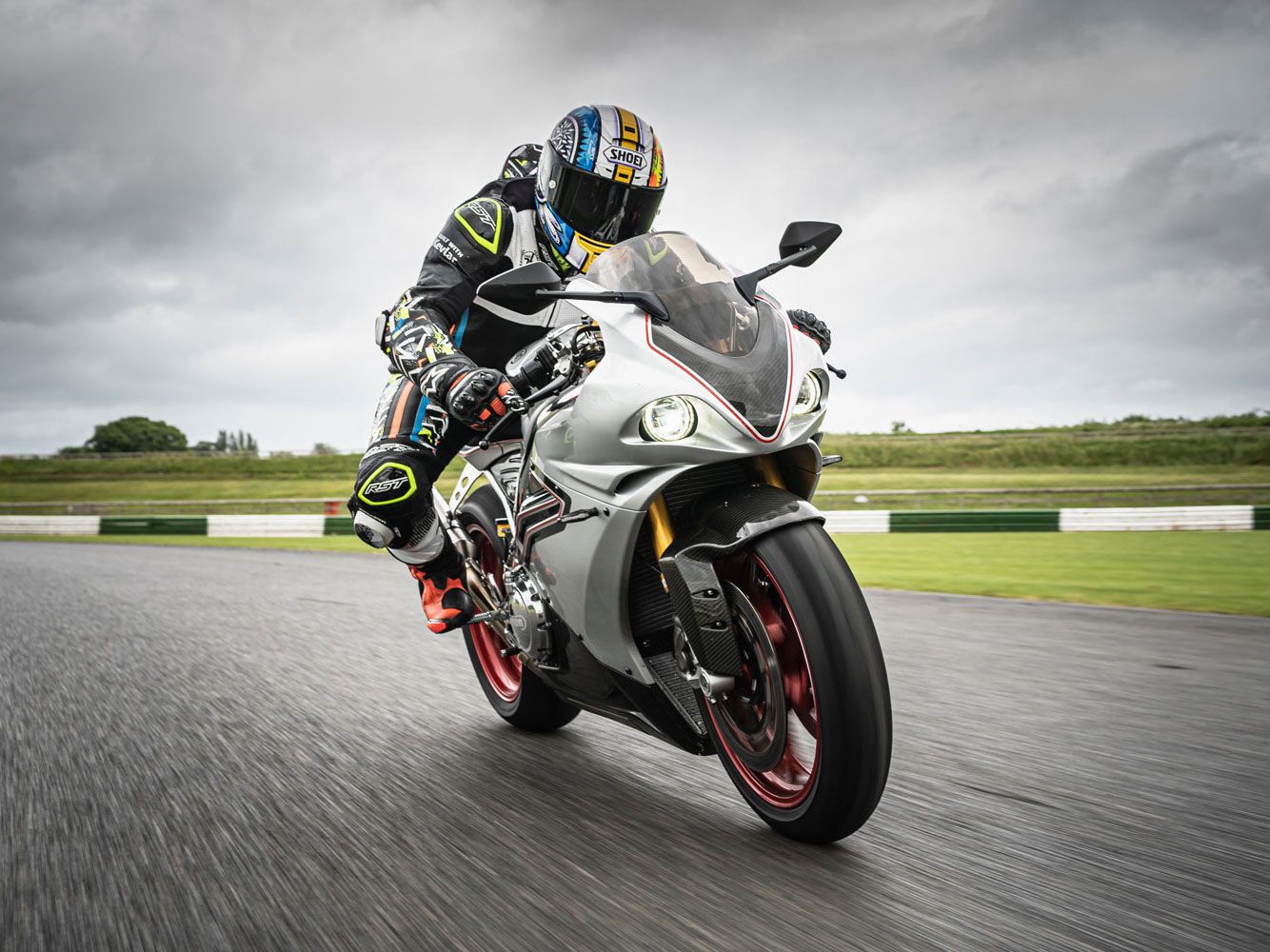
How do you convince the world that you’ve changed? That the past is the past and the future will not only be different, but better? If you happen to be Norton Motorcycles, you build a state-of-the-art multimillion-pound headquarters and production facility, staff it with a skilled and highly focused workforce, and completely reengineer the machines that dented the brand’s image over the last few tumultuous years.
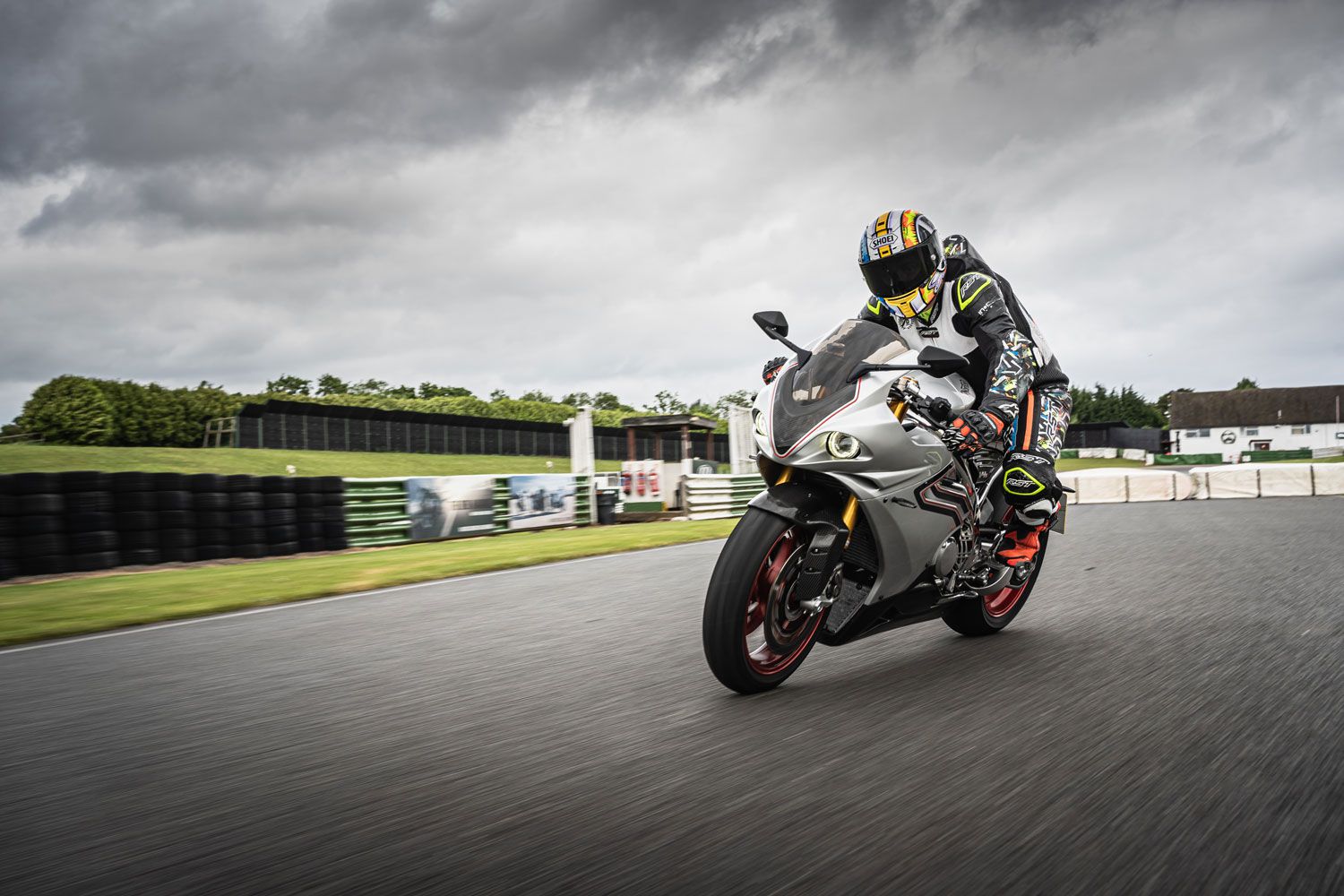
The bike in question is the Norton V4SS superbike, the 1 that promised so much but which, under the ownership of now-disgraced Stuart Garner, became mired in controversy. Customer deposits were paid but bikes weren’t delivered. There were issues with reliability, quality, and even safety.
In April 2020, Indian manufacturing giant TVS Motor Company bought the famous Norton brand, and in a short space of time—and in the midst of the global pandemic—restructured Norton’s business and began restoring the public’s love for the marque. Absolutely central to that process was correcting the defects and addressing the supply issues that blighted the old regime’s motorcycles. The “new Norton” team identified no fewer than 35 problems and set out on a project to completely reengineer the V4SS in order to rectify every fault and improve reliability and longevity.
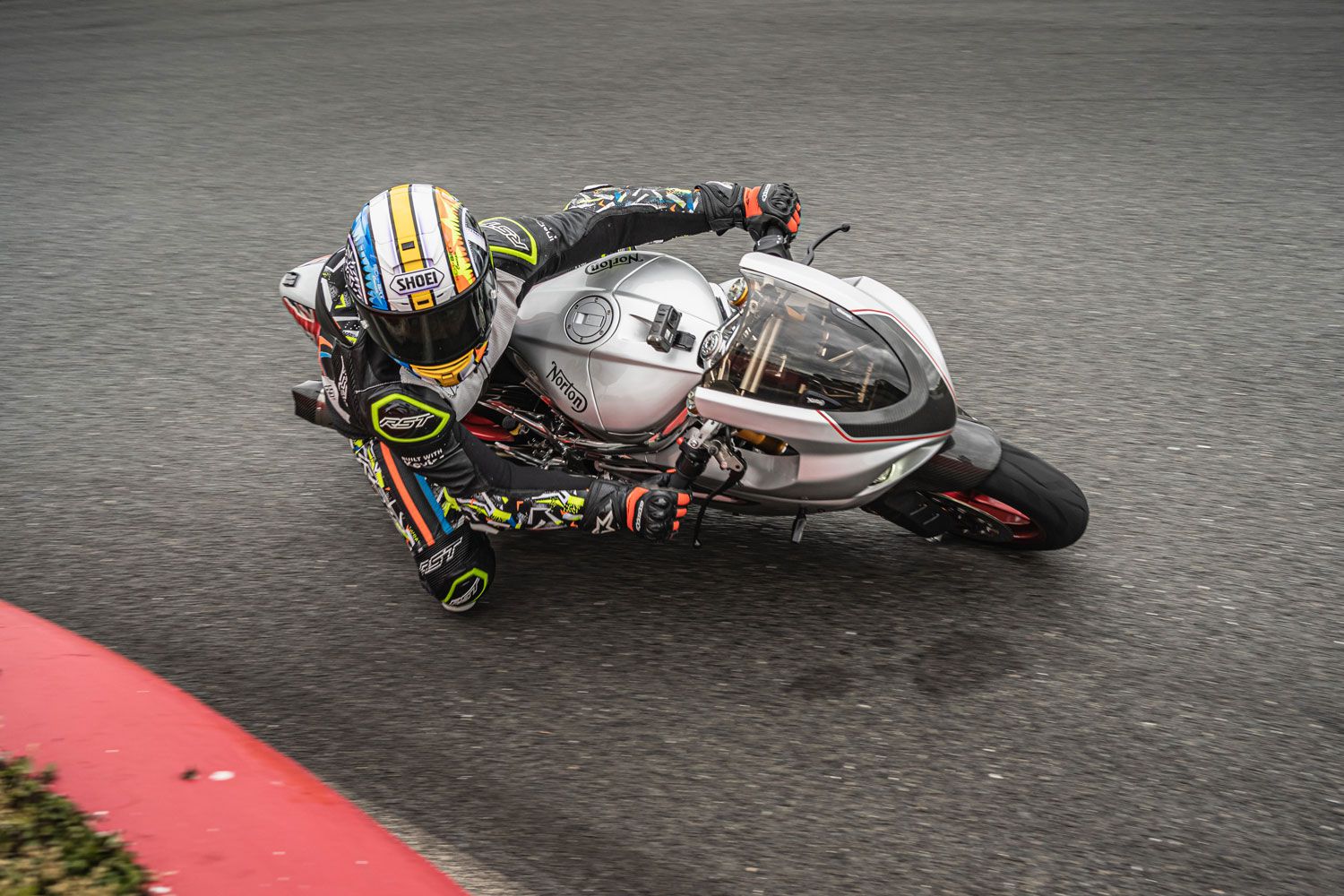
The new Norton stripped back the old V4SS, looked at and tested each component, and then rebuilt, redesigned, or spec’d entirely new parts where necessary. At every turn, quality control and craftsmanship were paramount. The result is basically an entirely new bike.
And this is it: the new V4SV by the new Norton. Motorcyclist rode it at the Mallory Park racetrack, not too far from the new company’s new headquarters in the heart of the British midlands.
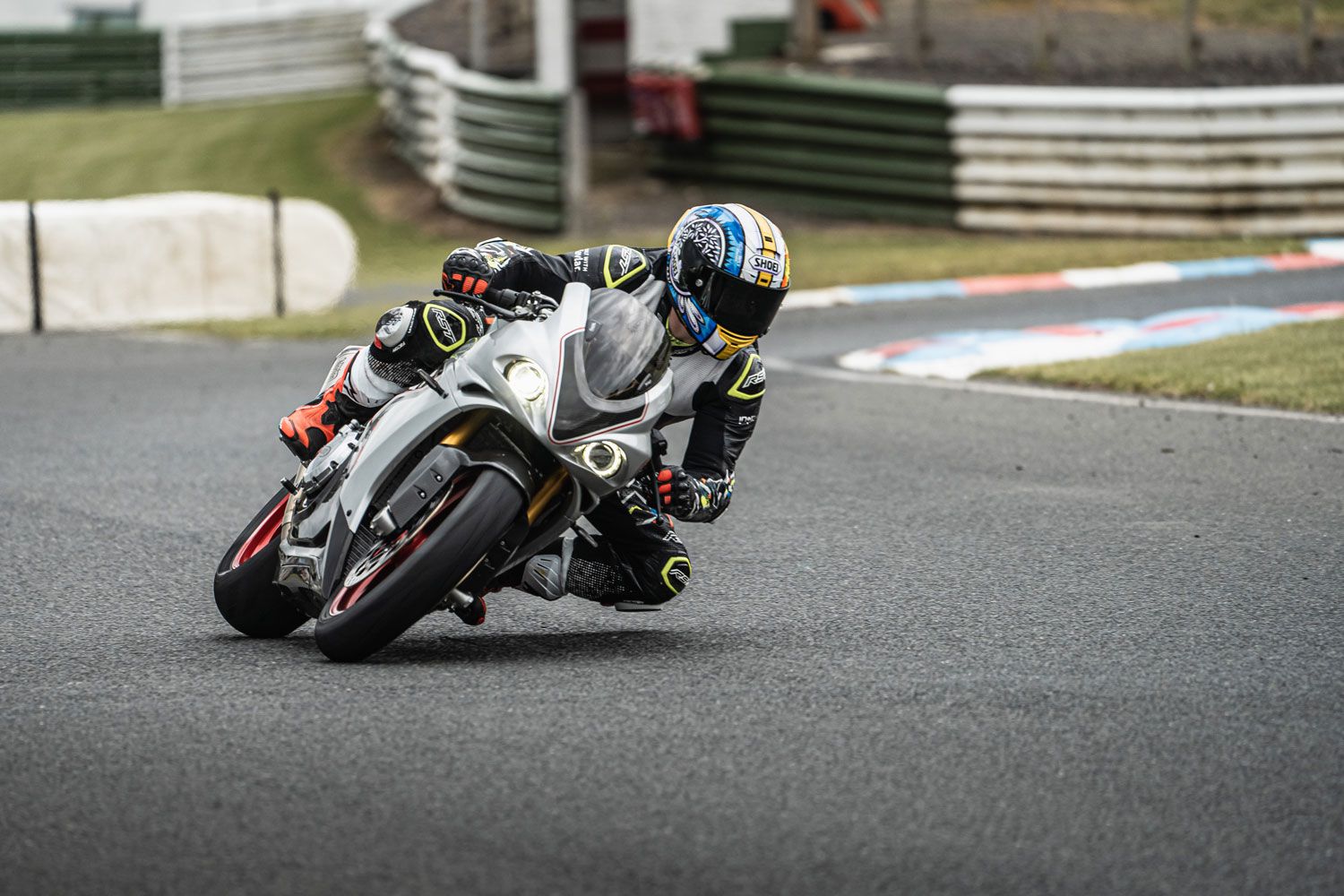
The old V4SS was shot through with problems ranging from a leaking fuel tank to substandard electrics and, perhaps most distressing, low-quality welding on the frame and swingarm. Its subsequent reengineering into the V4SV was a costly and time-consuming job, but it had to be done even though some customers are still waiting for bikes ordered from the “old” Norton.
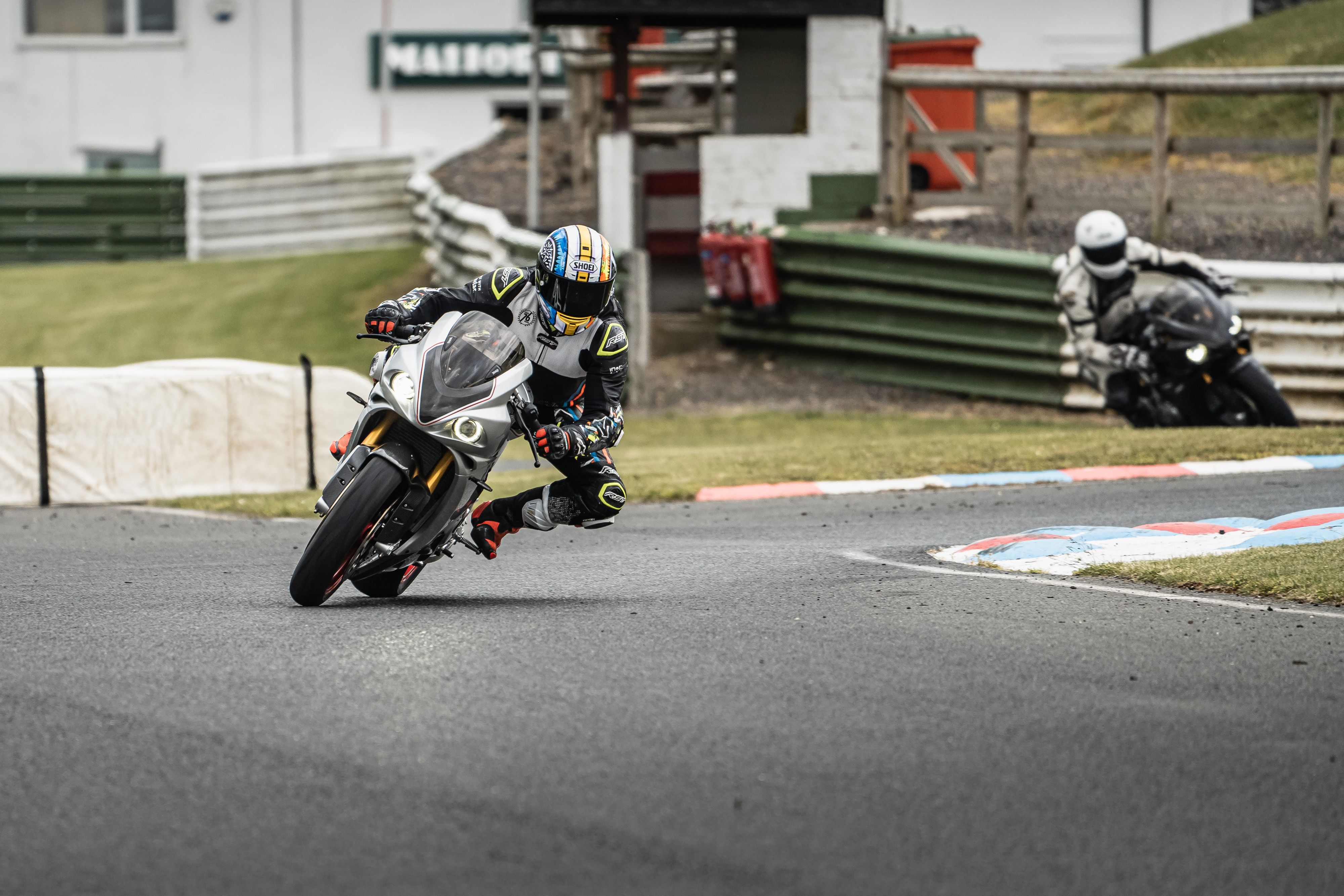
Despite its obvious connection with the V4SS, the V4SV is very much a new model. It uses a reengineered version of the 72-degree 1,200cc V-4 used in the original bike; numbers are claimed 185 hp at 12,000 rpm and 92.2 pound-feet of torque at 9,000 rpm, down on both power and torque compared to the 200 hp plus once claimed for the V4SS.
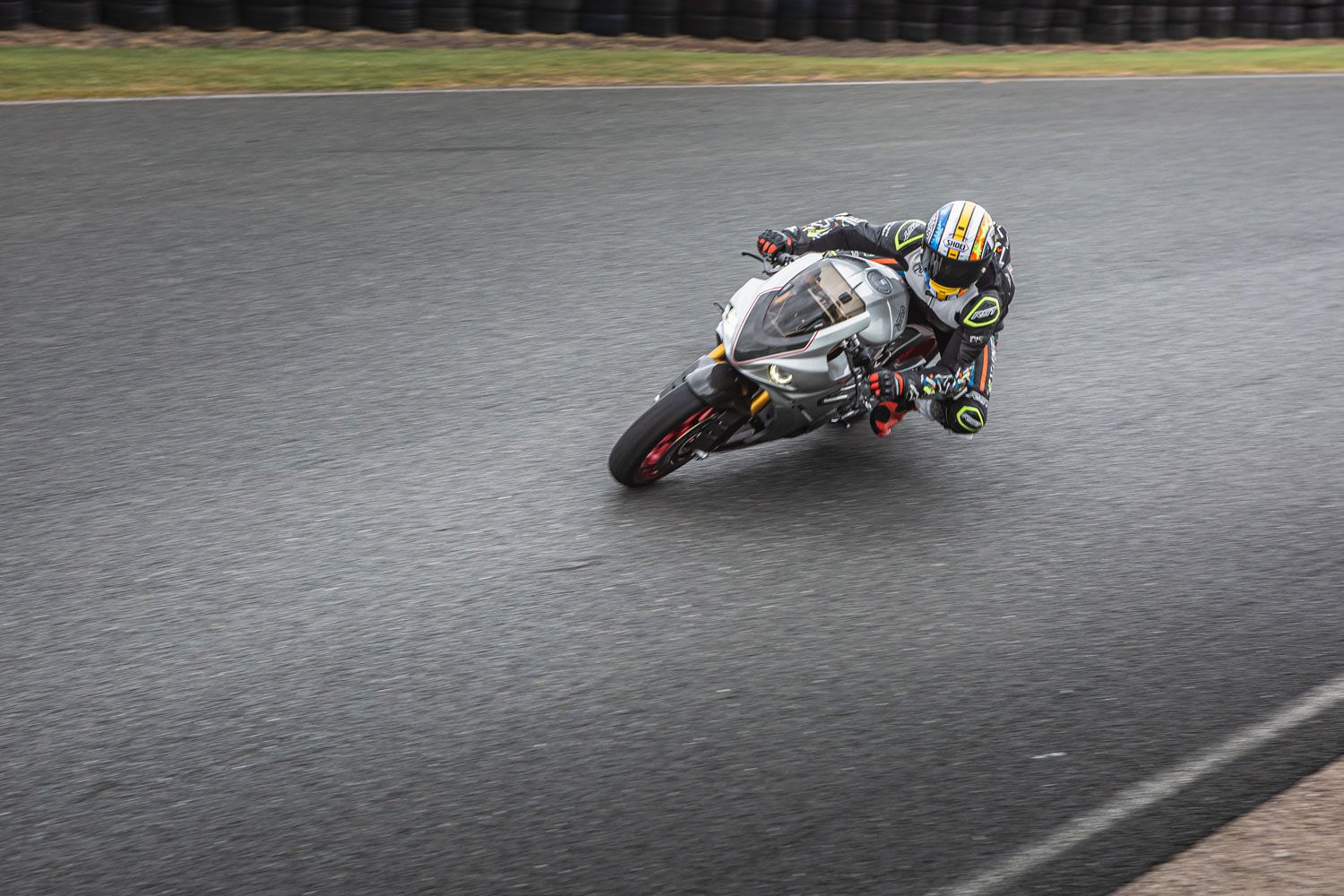
The hand-polished, handcrafted, TIG-welded frame is also similar to that seen on the V4SS, but redesigned and with new welding. Suspension is provided by Öhlins, with a manually adjustable NIX 30 43mm fork and a bespoke TTX GP rear shock. So, yes, it looks like the old bike, but underneath it’s all new.
There are still two models to choose from, the Manx Silver and the Carbon, with the only difference being the looks and the BST carbon wheels on the Carbon model.
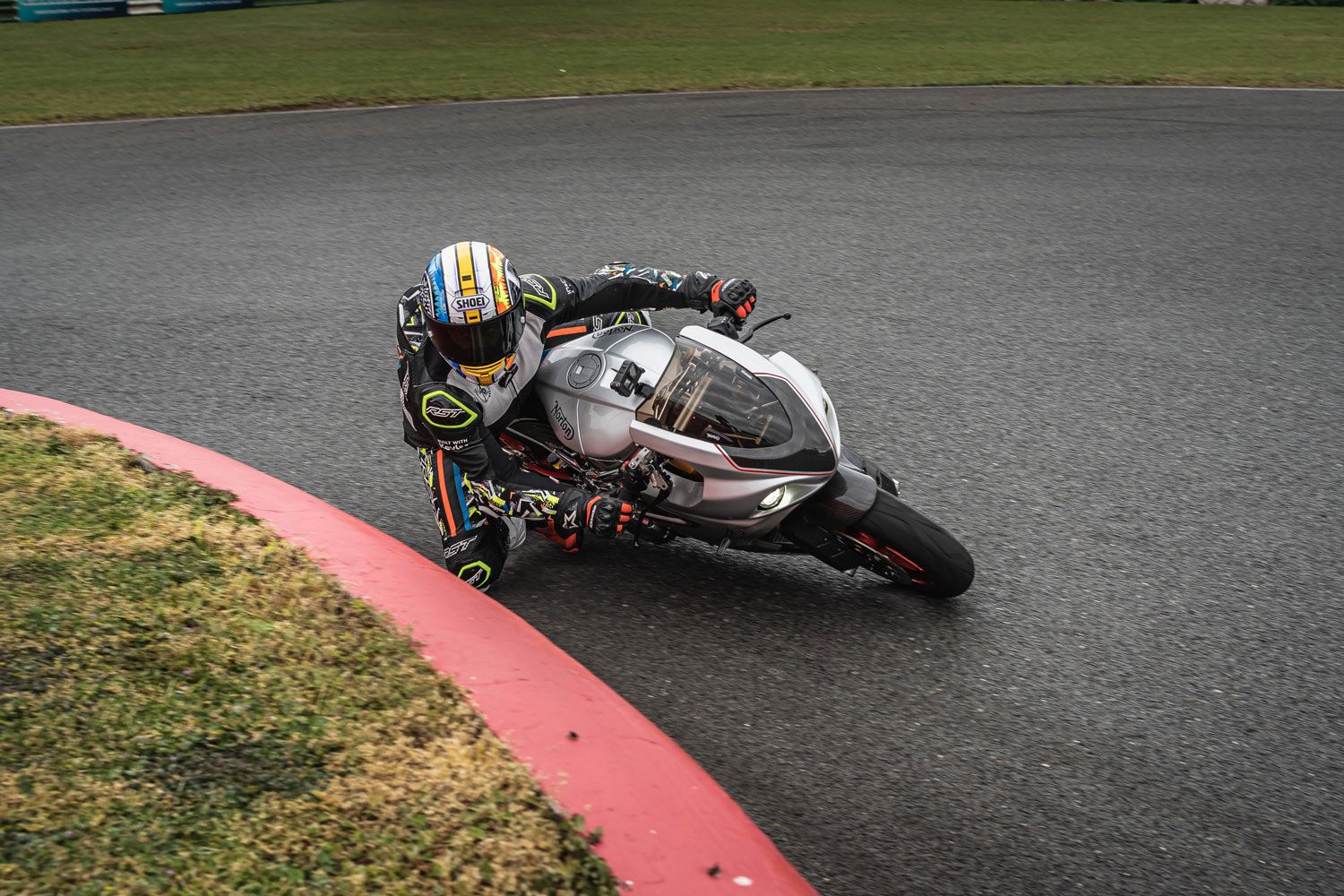
Despite the bike’s connection with the Isle of Man TT races, at which the older V4SS was raced on several occasions, Norton is keen to emphasize that this is a road-going superbike and not a race machine with mirrors. And while the V4SV press launch was held at a racetrack, the testbikes were equipped with road-biased Dunlop SportSmart TT tires, first introduced back in 2018. There wasn’t a tire warmer in sight.
An examination of the V4SV’s specs reveals why Norton is pushing the road element rather than the track: The bike is significantly down on power and torque compared to the superbike competition, much of which sits happily in the 200-hp-plus club. Ducati’s Panigale V4 S, perhaps the Norton’s closest rival, produces a quoted 215.5 hp at 13,000 rpm, considerably more than the British bike. The hand-built Norton, however, produces slightly more peak torque and does so lower in the rev range.
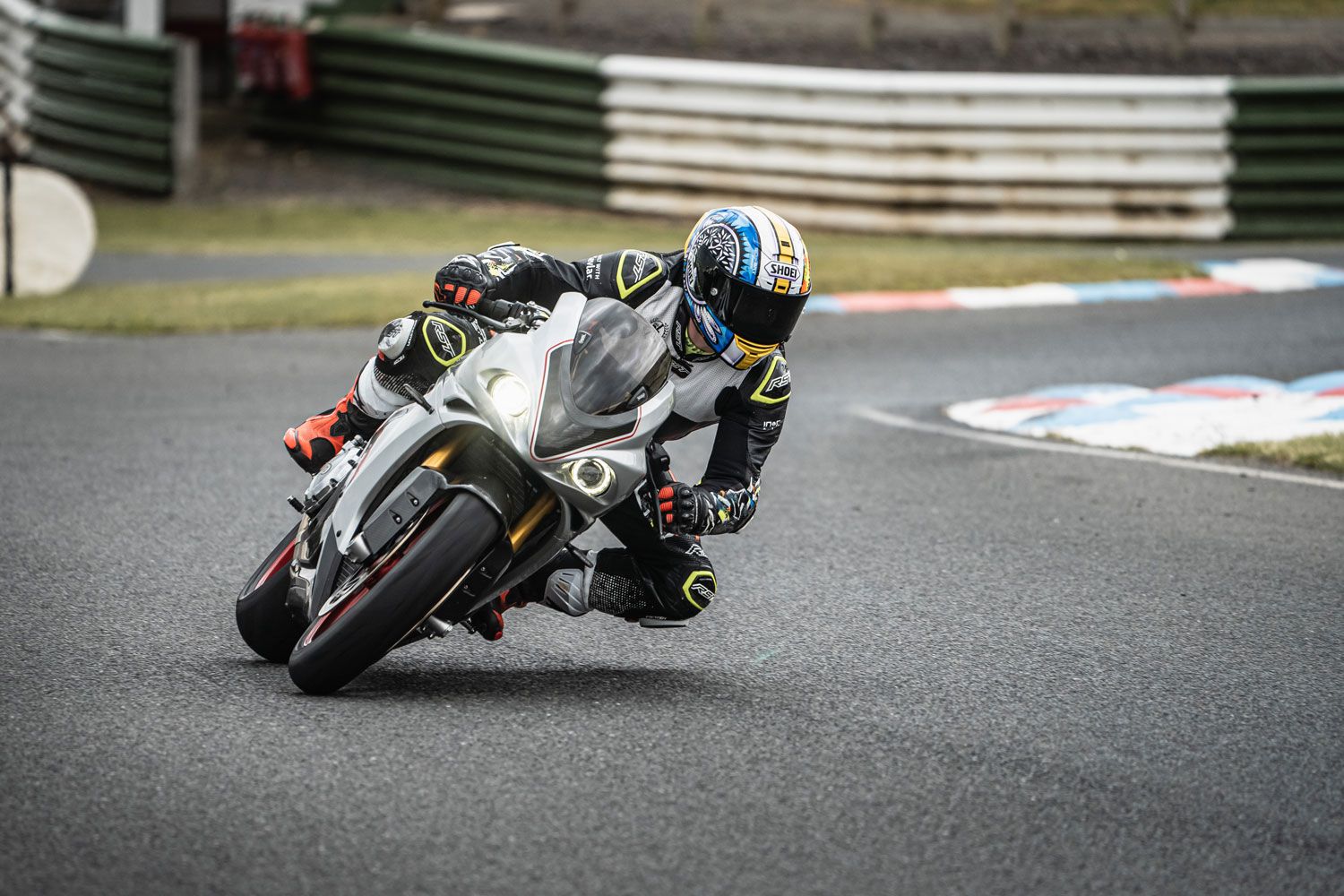
But even in the distinctly unglamorous Mallory Park paddock—think the rough ‘n’ ready Transatlantic Trophy days of Kenny Roberts versus Barry Sheene in the late 1970s—the new V4SV shines. It remains evocatively reminiscent of the TT racebikes. The unconventional single-sided swingarm and Union Jack rear seat unit catch the eye immediately, while the billet machined footpeg assembly and new silver and carbon bodywork are stunning. The front sprocket cover is simply a work of art. And the designers’ decision to stick with the older bike’s hand-stitched single seat can only be applauded.
There are no fancy aero wings on this “luxury” superbike for the road but, unlike the old V4SS, the V4SV does get rearview mirrors. Once on board you’re greeted by a full-color 6-inch screen, which incorporates a rearview camera. Ignition is keyless, so it’s a press of the “On” button incorporated into the dummy carbon fuel tank (3.96 gallons of fuel is stored under the seat) and the smartly presented dash comes alive.
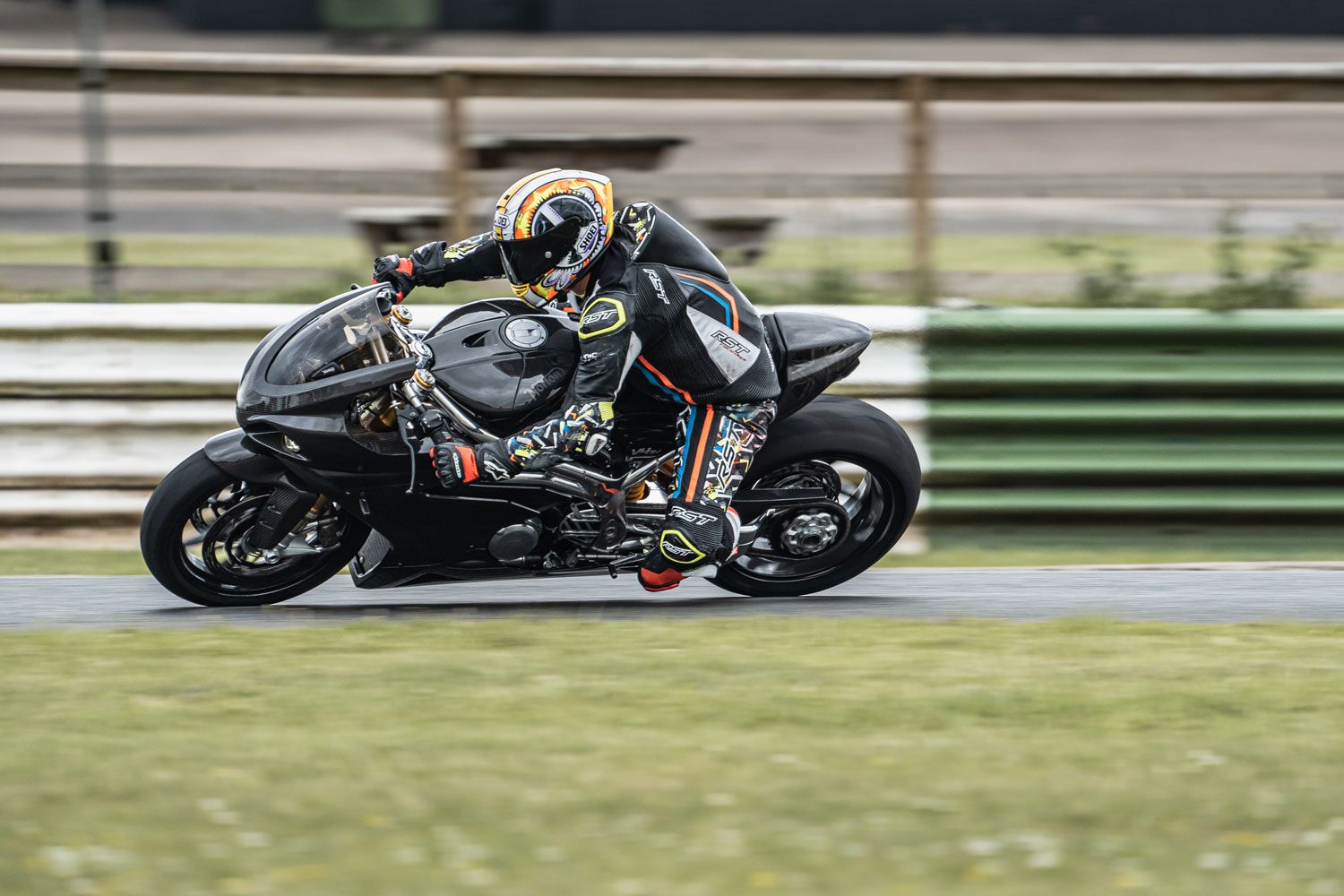
The view from the seat is purposeful: polished billet top yoke, protruding Öhlins fork, and a large manually adjustable Öhlins steering damper. The switch gear is Aprilia-like, with a toggle on the left bar that allows you to opt for one of three different riding modes, Wet, Road, or Sport. Each mode changes the engine character, throttle response, and the interaction of the rider aids.
All rider aids including traction control, which incorporates wheelie control, are linked to the six-axis IMU, but ABS is not and is therefore not lean-sensitive. Nor is there either launch control or engine-brake assist, and the electronic rider aids can’t be customized, meaning the TC and wheelie control are factory set and can’t be trimmed.
So, yes, given that virtually all 2022 machines in the superbike category feature 200 bhp outputs, multiple rider aids (including cornering ABS), and electronic semi-active suspension, the Norton feels a little old-school. But this isn’t a negative, more a recalibration to an earlier time.
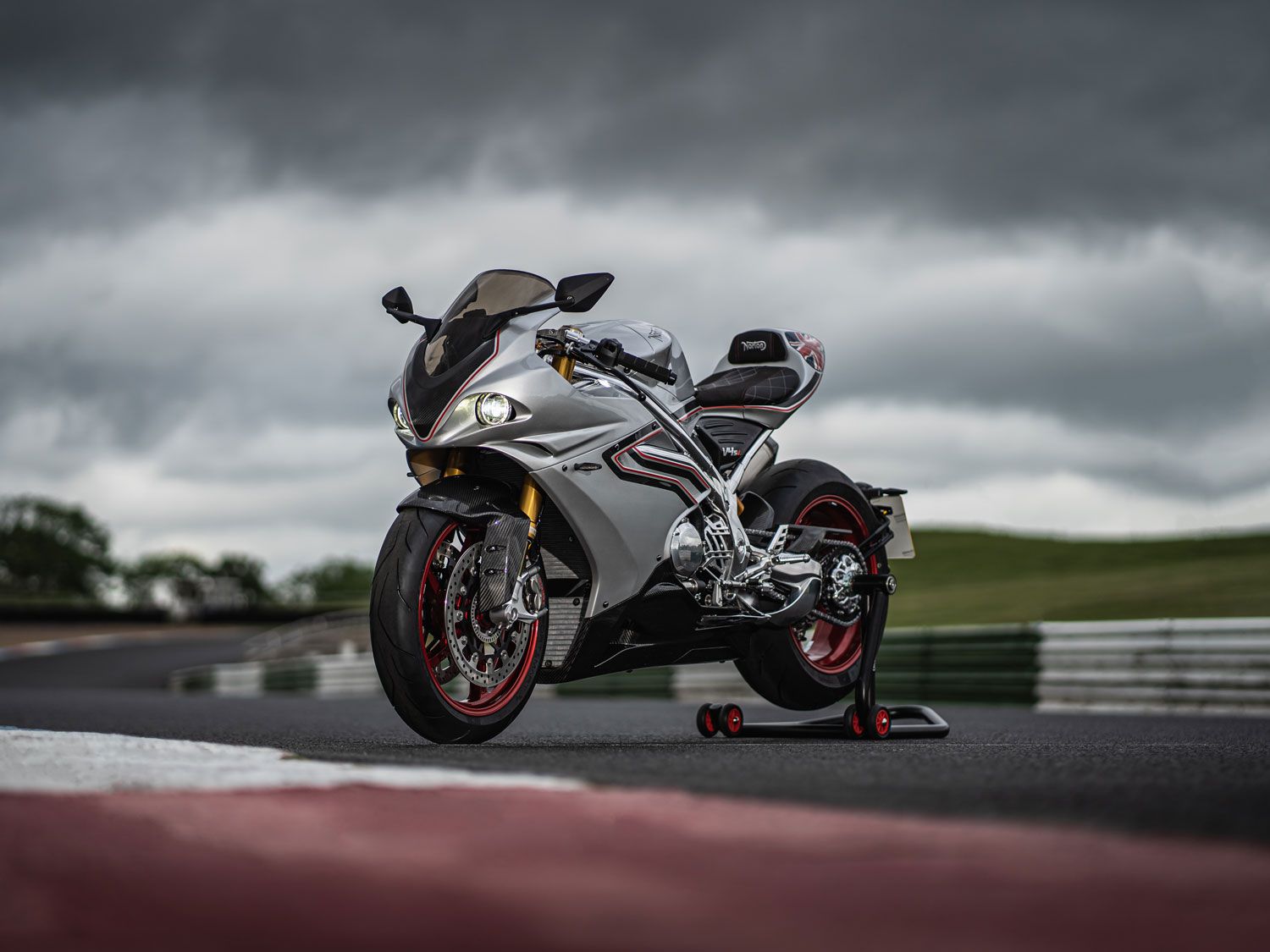
Up-and-down clutchless gear changes with the quickshifter are smooth, which is fortunate as the clutch is a little heavy. The Öhlins suspension is plush, not soft, but certainly not racebike firm. There are feel and movement, plus a one-to-one connection between the rider and the bike. You can feel the Dunlops coming up to temperature.
Norton’s quoted peak of 185 hp feels about right. Considering it’s 20 to 30 hp down on the competition, the V4SV is deceptively quick, pulling strongly while accompanied by a lovely V-4 howl from the exhaust. Note that the V4SV isn’t Euro 5 approved, and is therefore free to shout a little louder than some.
It’s easy to change the riding modes on the move by closing the throttle, and the dash changes the graphics to a checkered flag to indicate the move into Sport mode. It’s refreshing to have an intuitive dash; even the rear-facing camera is simple and fun to use, especially when you switch it on as you exit a corner and see the rear tire lay down a satisfying black line of rubber.
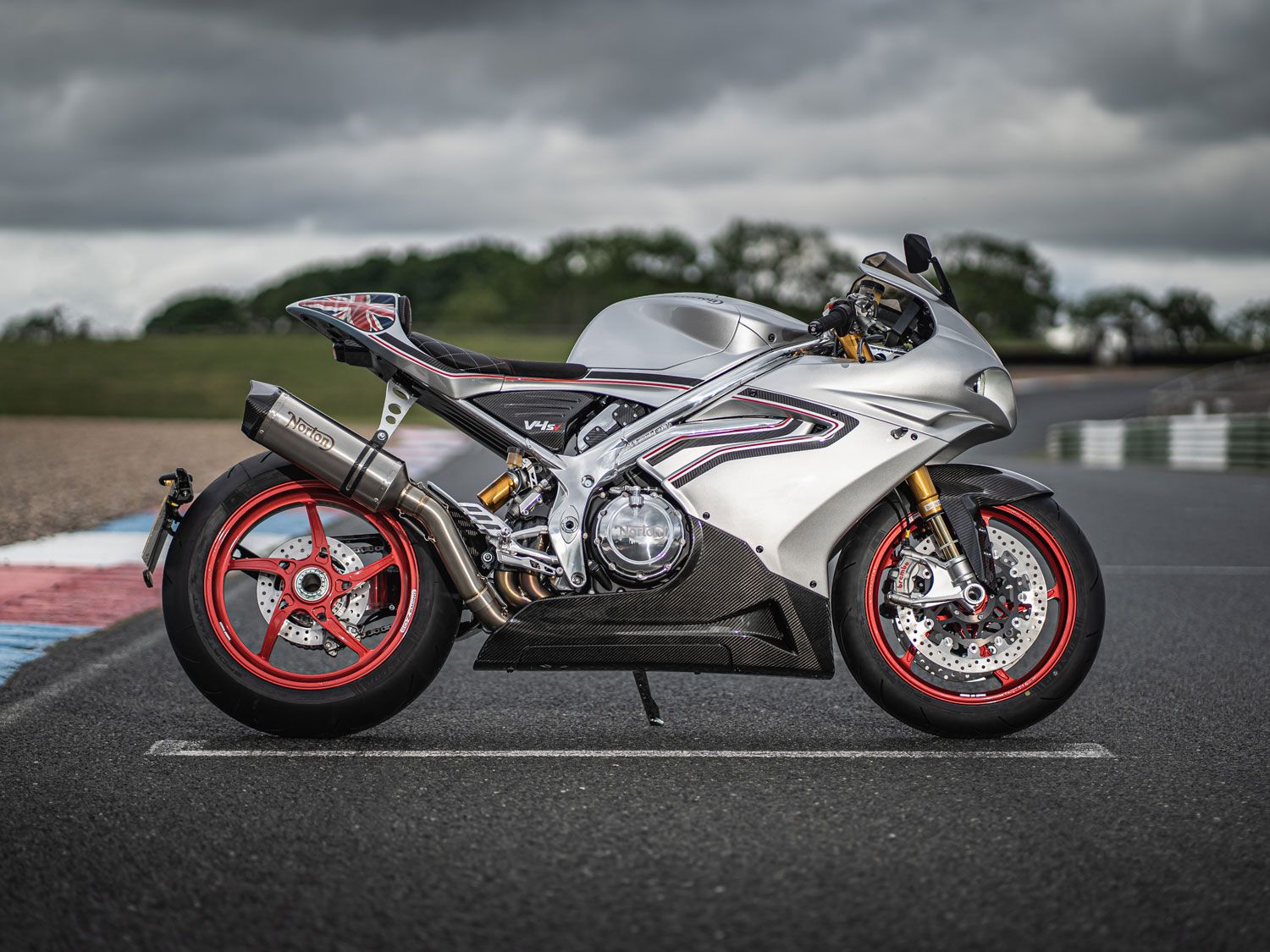
But it’s here that the Norton V4SV will divide opinion, especially when compared to the competition. The Ducati Panigale V4 S, the epitome of a modern V-4, loves revs. Take it to 14,500 rpm, bounce it off the limiter, then hold onto those screaming rpm between turns.
But while you can make the Norton scream, it’s not the best approach. While the Panigale makes peak power at 13,000 rpm, and Honda’s Fireblade at 14,500 rpm, the Norton’s peak, as mentioned before, comes at a relatively low 12,500.
Only Aprilia’s V-4 makes more torque in class than the Norton, and it’s that strength in the midrange that makes the V4SV special—an abundance of easy torque that invites you to short-shift through the smooth gearbox, then let off the brakes and carry plenty of corner speed. It doesn’t want to be ridden aggressively. Better to let it flow and find its way, like an older V-twin or Honda RC45. Once you settle into that style of riding, the Norton becomes an effortless joy to flow around a racetrack.
The suspension setup is a little soft at the rear, but the front is near faultless. The supple ride of the Öhlins suspension gives feedback and confidence, and encourages you to dial in all that torque earlier and earlier.
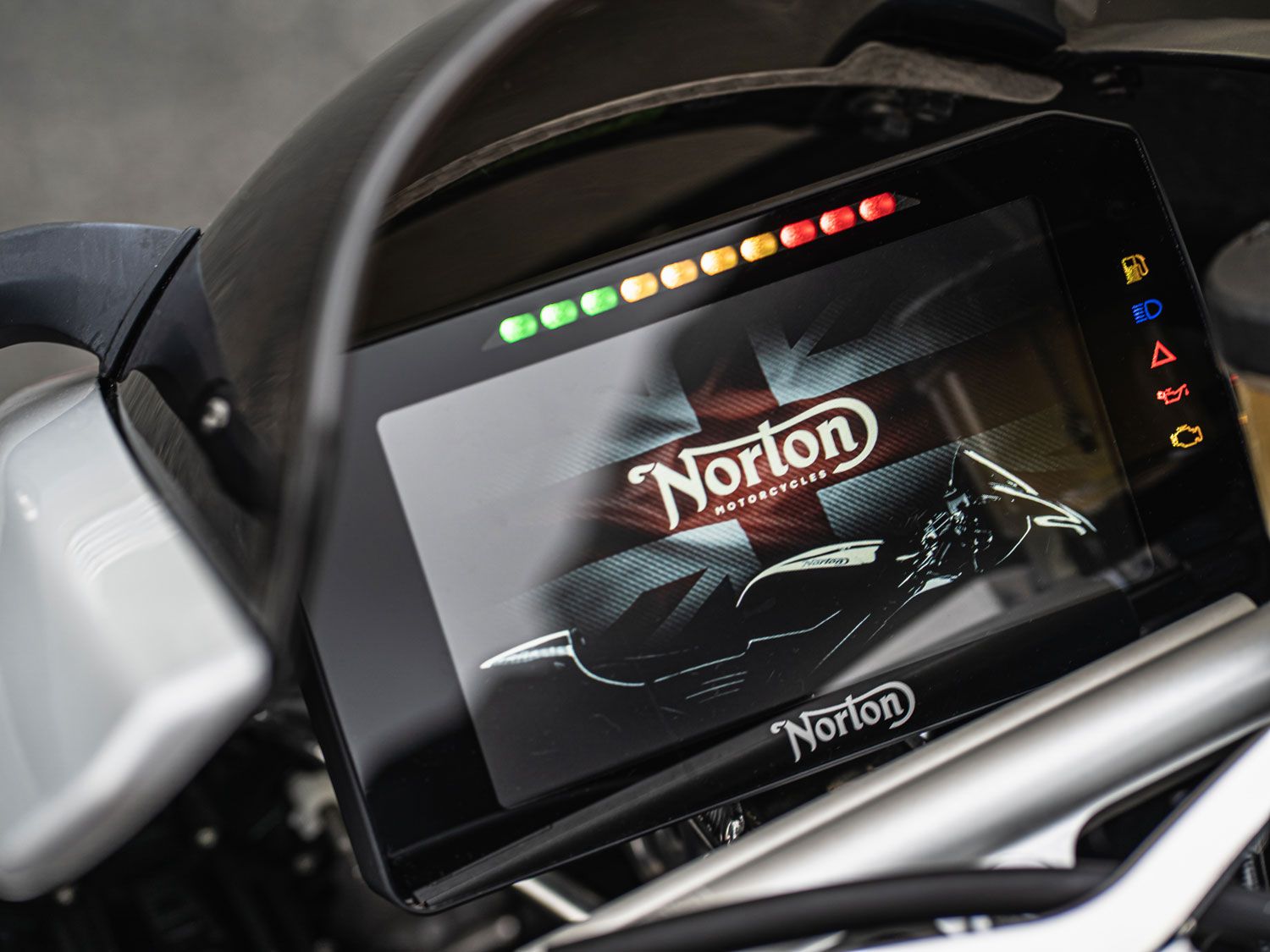
Bodywork is small, so it’s hard to get properly tucked in. That’s not a problem at a relatively short track like Mallory but would become an issue at the bigger circuits like Silverstone or Mugello. So a larger screen—as used by the TT racers—would be a welcome option.
Verdict
Look at the dyno and performance figures as well as lap times and the Norton is clearly down compared to the competition. Even if we fitted slicks and tweaked the manually adjustable suspension, the competition would lap quicker. In fact, a slightly less expensive Panigale would eat the Norton for breakfast; even the ‘“cheaper” 30th Anniversary Fireblade would show it a clean pair of heels without breaking into a sweat.
But forget about the stopwatch and remember that this is a redesigned, reengineered iteration of a 2018–2019 motorcycle, so we are not comparing like for like. New Norton has done some serious reinventing, putting in hundreds of hours of dyno testing and 70,000 road and track miles. The V4SV is the bike the V4SS should have been and should now be reliable too.
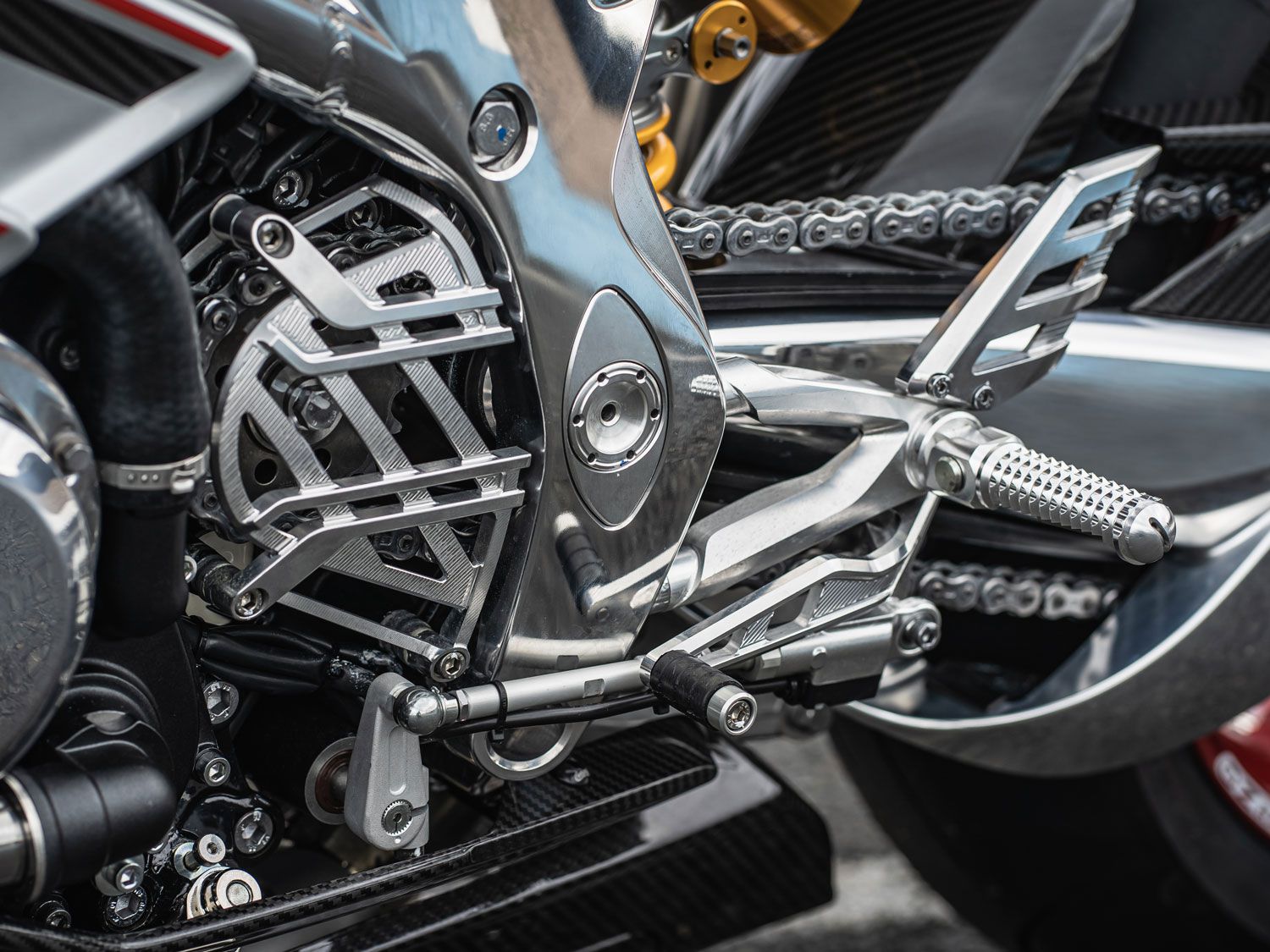
It’s easy to ride and has usable torque, with excellent street-biased handling that can be easily tweaked for the track. Fit some slicks, fiddle with the suspension, and you won’t be a million miles away from the front of a trackday. Some will be perturbed by the basic level of rider aids; others will love it just because it says Norton on the side. They won’t care one jot or tittle if their bike is a few horses down.
2022 Norton V4SV Technical Specifications and Price
| PRICE | 44,000 pounds sterling (UK) |
| ENGINE | 1,200cc, liquid-cooled, 72-degree V-4; 4 valves/cyl. |
| BORE x STROKE | 82.0 x 56.8mm |
| COMPRESSION RATIO | 13.6:1 |
| FUEL DELIVERY | Fuel injection w/ ride-by-wire |
| CLUTCH | Wet, multiplate slipper |
| TRANSMISSION/FINAL DRIVE | 6-speed/chain |
| FRAME | Alloy tubular, TIG-welded, hand polished |
| FRONT SUSPENSION | 43mm Öhlins NIX 30, fully adjustable; 4.7 in. travel |
| REAR SUSPENSION | Öhlins TTX GP, fully adjustable; 5.0 in. travel |
| FRONT BRAKES | 4-piston Brembo calipers, dual 330mm discs w/ ABS |
| REAR BRAKE | 2-piston Brembo caliper, 245mm disc w/ ABS |
| WHEELS, FRONT/REAR | Carbon or alloy ; 17 x 3.5 in. / 17 x 6.0 in. |
| TIRES, FRONT/REAR | Dunlop SportSmart TT; 120/70-17 / 200/55-17 |
| RAKE/TRAIL | 23.9°/3.9 in. |
| WHEELBASE | 56.5 in. |
| SEAT HEIGHT | 32.7 in. |
| FUEL CAPACITY | 4.0 gal. (US) |
| DRY WEIGHT | 425 lb. |
| WARRANTY | 24 months |
| CONTACT | nortonmotorcycles.com |
Source: MotorCyclistOnline.com
